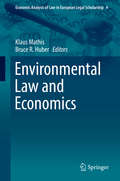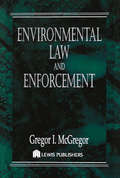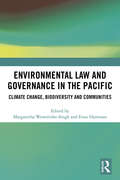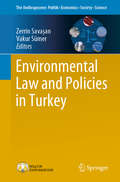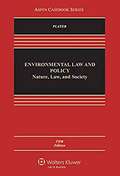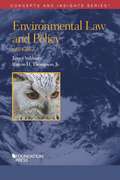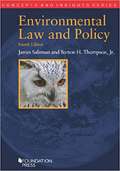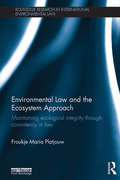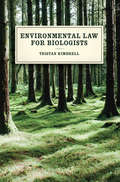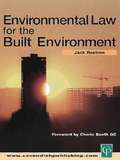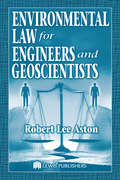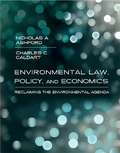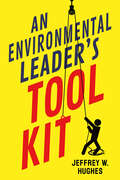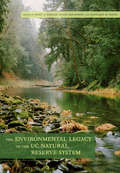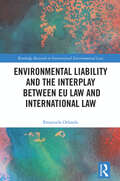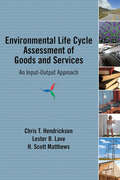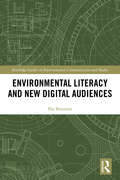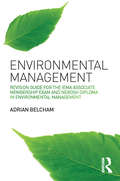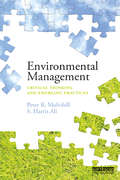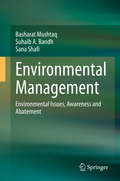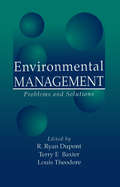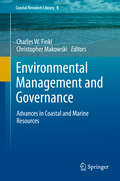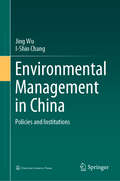- Table View
- List View
Environmental Law and Economics
by Klaus Mathis Bruce R. HuberThis anthology discusses important issues surrounding environmental law and economics and provides an in-depth analysis of its use in legislation, regulation and legal adjudication from a neoclassical and behavioural law and economics perspective. Environmental issues raise a vast range of legal questions: to what extent is it justifiable to rely on markets and continued technological innovation, especially as it relates to present exploitation of scarce resources? Or is it necessary for the state to intervene? Regulatory instruments are available to create and maintain a more sustainable society: command and control regulations, restraints, Pigovian taxes, emission certificates, nudging policies, etc. If regulation in a certain legal field is necessary, which policies and methods will most effectively spur sustainable consumption and production in order to protect the environment while mitigating any potential negative impact on economic development? Since the related problems are often caused by scarcity of resources, economic analysis of law can offer remarkable insights for their resolution. Part I underlines the foundations of environmental law and economics. Part II analyses the effectiveness of economic instruments and regulations in environmental law. Part III is dedicated to the problems of climate change. Finally, Part IV focuses on tort and criminal law. The twenty-one chapters in this volume deliver insights into the multifaceted debate surrounding the use of economic instruments in environmental regulation in Europe.
Environmental Law and Enforcement
by Gregor I. McGregorAmid all the laws and regulations on environmental protection and worker safety, what is the responsible business or landowner to do? What should the responsible consultant advise? Environmental Law and Enforcement provides you with a practical guide that takes the mystery out of environmental law and related land use controls.The author provides a synopsis of major environmental topics from A to Z and features citations to the major federal statutes in the United States Code (USC) and the Code of Federal Regulations (CFR) so you can easily find governing statutes and regulations. Special sections discuss the use of experts in case preparation and how to be an effective case witness. A checklist for compliance with the National Environmental Policy Act is included. The book covers strategies to cope with landowner liability for hazardous waste, consultant liability for mistakes in hazardous waste site assessments, and guidelines for emergency managers to minimize legal liability. The section on insurance liability provides practical approaches to dealing with insurance companies on hazardous waste claims. The successful organization will manage for environmental protection as a corporate goal, and consequently stays ahead of new government requirements-away from lawyers and lawsuits-and ahead of the competition. Environmental Law and Enforcement gives you the tools you need to achieve this mission.
Environmental Law and Governance in the Pacific: Climate Change, Biodiversity and Communities
by Margaretha Wewerinke-Singh Evan HammanThis volume examines environmental law and governance in the Pacific, focusing on the emerging challenges this region faces. The Pacific is home to some of the world’s most astonishing biological and cultural diversity. At the same time, Pacific Island nations are economically and technically under-resourced in the face of tremendous environmental challenges. Destructive weather events, ocean acidification, mining, logging, overfishing, and pollution increasingly degrade ecosystems and affect fishing, farming, and other cultural practices of Pacific Islanders. Accordingly, there is an urgent need to understand and analyse the role of law and governance in responding to these pressures in the Pacific. Drawing on academic and practitioner expertise from the Pacific region, as well as Europe and the United States, this unique collection navigates the major environmental law and governance challenges of the present and future of the Pacific. Environmental Law and Governance in the Pacific discusses 21 Pacific Island countries and territories, including Cook Islands, Fiji, Papua New Guinea, Solomon Islands, Vanuatu, and Samoa, and a broad range of themes, such as deep-sea mining, wetlands and mangroves, heritage, endangered species, human rights, and access to justice, are addressed, thus providing a comprehensive and state-of-the-art overview of environmental law and governance within specific jurisdictions as well as across the Pacific region as a whole. This volume will be essential reading for students and scholars interested in environmental law and governance in the Pacific region, as well as policy-makers, practitioners and NGOs involved in the development and implementation of environmental law and policy.
Environmental Law and Policies in Turkey (The Anthropocene: Politik—Economics—Society—Science #31)
by Vakur Sümer Zerrin SavaşanThis book aims to provide a general systematic analysis of key issues of Turkish environmental law and policies and to highlight the related concerns and challenges. Its chapters provide a historical perspective and general understanding of the legal settings of Turkish Environmental Law; offer an overall understanding of the evolving and prevailing paradigms of legislation and administrative practices in environmental policy in Turkey; explain how EIA has become the main environmental management tool and instrument of environmental compliance in Turkey; discuss the project process, challenges and results of the EU-funded project ‘Turkey’s Map of Environmental Violations’ and food security in Turkey; and present a picture of environmental justice movements from bottom-up over the establishment and operation of small-scale hydroelectricity power plants.Thus, with its comprehensive coverage of up-to-date information and findings enabling the reader to understand the topic in full analyses of key themes in Turkish environmental law and policies, addressing, in separate chapters, concepts like environmental justice, food security, environmental compliance, environmental impact assessment (EIA), and environmental cases in Turkey in detail multidisciplinary approach enabling readers to learn about the topic in a holistic mannerit aims to be:• a valuable source of information about Turkish environmental law and policies• an effective tool to support teaching and research on Turkish environmental law and policies• an aid to decision-making on Turkish environmental issues• an important resource for graduate and postgraduate research students and policymakers working on Turkish environmental law and policies Given there is no competitive book on the market with similar coverage, it makes a meaningful contribution to Turkish environmental scholarship
Environmental Law and Policy: Nature, Law, and Society (Aspen Casebook)
by Zygmunt J. B. Plater Robert H. Abrams Robert L. Graham Lisa Heinzerling David A. Wirth Noah D. HallEnvironmental Law & Policy: Nature, Law & Society is a coursebook designed to access the law of environmental protection through a “taxonomic” approach, exploring the range of legal structures and legal methodologies of the field—rather than simply designing it according to air, water, toxics, etc. as subject media (which often results in duplicative legal coverage). All the major subject areas of pollution and resource conservation are covered, but they are covered according to the legal approaches they represent. <p><p> The book is “Saxist,” because it originally arose and continues to carry on themes from the teaching, guidance, and writings of the late Joseph Sax, the eminent pioneer of the environment law field who emphasized the interaction between common law and public law statutory structures, and introduced the public trust doctrine as a thread undergirding and running through the entire field of environmental law.
Environmental Law And Policy (Concepts And Insights)
by James Salzman Barton ThompsonEnvironmental Law and Policy is a user-friendly, concise, inexpensive treatment of environmental law. Written to be read pleasurably rather than used as a dry reference source, the authors provide a broad conceptual overview of environmental law while also explaining the major statutes and cases. The updated text also describes initiatives launched by the Trump administration. The first part of the book provides an engaging discussion of the major themes and issues that cross-cut environmental law. The second part of the book examines the substance of environmental law, with separate sections on each of the major statutes. The third part of the book describes natural resources law, discussing endangered species conservation, wetlands protection, water and energy issues. Part four addresses environmental impact statements and the National Environmental Policy Act. The book has wide adoption, not only in law schools, but also in graduate and undergraduate classes outside law school.
Environmental Law and Policy (Concepts and Insights)
by James Salzman Barton H. ThompsonEnvironmental Law and Policy is a user-friendly, concise, inexpensive treatment of environmental law. Written to be read pleasurably rather than used as a dry reference source, the authors provide a broad conceptual overview of environmental law while also explaining the major statutes and cases. A series of problem exercises have been added throughout the book, describing a legal or policy conflict in detail and asking students to identify and assess solutions. The first part of the book provides an engaging discussion of the major themes and issues that cross-cut environmental law. The second part of the book examines the substance of environmental law, with separate sections on each of the major statutes. The third part of the book describes natural resources law, discussing endangered species conservation, wetlands protection, water and energy issues. Part four addresses environmental impact statements and the National Environmental Policy Act.
Environmental Law and the Ecosystem Approach: Maintaining ecological integrity through consistency in law (Routledge Research in International Environmental Law)
by Froukje Maria PlatjouwThe ecosystem approach embodies a concept of the environment which emphasizes the integrated components of nature as complex adaptive systems. This book examines the relationship between the architecture and design of environmental law and the implementation of the ecosystem approach as a means to maintain ecological integrity. The main issue addressed is: in which manner and to what extent does fragmentation and administrative discretion in environmental law impede the implementation of an ecosystem approach? This is explored through analysis of several questions: what is an ecosystem approach and how could it be implemented; how can economic evaluation of ecosystem services contribute to the debate; to what extent is environmental law fragmented and how does this affect the implementation of the ecosystem approach; to what extent does environmental law contain administrative discretion and how does this affect the implementation of the ecosystem approach; is there a need for greater consistency, coherence and a stronger rule of law in environmental law in light of the ecosystem approach? The main focus is on Europe, with additional international comparisons where appropriate. The book concludes by providing a normative portrayal of future environmental law as protective, systemic and predictable.
Environmental Law for Biologists
by Tristan KimbrellEnvironmental law has an unquestionable effect on the species, ecosystems, and landscapes that biologists study--and vice-versa, as the research of these biologists frequently informs policy. But because many scientists receive little or no legal training, we know relatively little about the precise ways that laws affect biological systems--and, consequently, about how best to improve these laws and better protect our natural resources. With Environmental Law for Biologists, ecologist and lawyer Tristan Kimbrell bridges this gap in legal knowledge. Complete with a concise introduction to environmental law and an appendix describing the most important federal and international statutes and treaties discussed, the book is divided into four broad parts: laws that focus on individual species, like invasive species policies, the Endangered Species Act, and international treaties such as CITES; laws that focus on land, from federal public lands to agricultural regulations and urban planning; laws that focus on water, such as the Clean Water Act; and laws that focus on air, such as the Clean Air Act and international measures meant to mitigate global climate change. Written for working biologists and students alike, this book will be a catalyst for both more effective policy and enhanced research, offering hope for the manifold frictions between science and the law.
Environmental Law for The Built Environment
by Jack RostronThis book provides a concise exposition of the relevant law and techniques commonly used to meet the regulatory requirements concerning the built environment. It provides a much needed reference and learning text for the growing professional and student involved in the subject. Aspects of environmental law and technology covered include the administration and sources of law,town and country planning, water and air pollution, waste, integrated pollution control and the natural environment. It highlights the importance of cross-boundary control, describing in detail the European and international law and enforcement regimes, the agencies involved in town and country planning, procedures at inquiries and enforcement measures, as well as looking at future developments. The important new protocol for assessing the environmental impact of developments is explained in detail. The policy framework and technical processes involved in dealing with water pollution are explored in terms of abstraction, supply, discharge and classification. Air pollution is dealt with in terms of energy efficiency, nuclear power, transport and future potential developments, and the recent phenomenon of sick building syndrome is explored in some detail. Other areas covered include the regulatory and technical processes involved in dealing with contaminated land, recycling/re-use, incineration, import/export and the law, policy and technology of integrated pollution control. A detailed exposition is offered of the legal issues concerning protection of the countryside, birds and animals; the problem of genetically modified crops; forestry; and mining.
Environmental Law for Engineers and Geoscientists
by Robert Lee AstonToday’s engineering and geoscience student needs to know more than how to design a new or remedial project or facility. Questions of law and ambiguities of terms often occur in contracts for mining, landfills, site reclamation, waste depositories, clean up sites, land leases, operating agreements, joint ventures, and other projects. Work place situations arise where environmental compliance methods are challenged by enforcement agencies. Although the statutes, rules, and regulations may seem to be worded clearly and specifically, there are often questions in application and sometimes varied interpretations. Environmental Law for Engineers and Geoscientists introduces simplified American jurisprudence focusing on the legal system, its courts, terms, phrases, administrative law, and regulation by the agencies that administer environmental law. The book comprehensively covers the “big five” environmental statutes: NEPA, CAA, CWA, CERCLA, and RCRA. With the basic law chapter as a foundation, the book covers the practical applications of environmental law for geo-engineers. It concludes with a chapter on the growing area of expert witnessing and admissible evidence in environmental litigation — an area of law where success or failure increasingly depends on the exacting preparation and presentation of expert scientific evidence. Written by a professional mining and geological engineer and a practicing attorney, Environmental Law for Engineers and Geoscientists prepares students for the numerous environmental regulatory encounters they can expect when dealing with various statutes, laws, regulations, and agency rules that govern, affect, and apply to environmental engineering projects. It provides a working knowledge of how to judge whether or not a project is in compliance with regulations, and how to ensure that it is.
Environmental Law, Policy, and Economics: Reclaiming the Environmental Agenda
by Charles C. Caldart Nicholas A. AshfordTraces important legal, economic, and scientific developments in the environmental field through an examination of environmental law cases and commentaries by leading scholars, focusing on pollution prevention and control and emphasizing the evaluation, design, and use of the law to stimulate technological change and industrial transformation.
An Environmental Leader's Tool Kit
by Jeffrey W. HughesIf you want to tackle an environmental problem in your neighborhood but do not know where to start, An Environmental Leader's Tool Kit can help. In this handbook, Jeffrey W. Hughes shares the proven strategies you need to step up and get meaningful action done.From designing a pilot study to managing contentious public meetings and more, Hughes walks you through the essentials of effective place-based environmental efforts. Among the tools you will find here are worksheets to kickstart brainstorming, appendixes that demystify jargon you might encounter, and illuminating, real-life examples. Down-to-earth and stimulating, An Environmental Leader's Tool Kit is a launchpad for those ready to make a difference now.
The Environmental Legacy of the UC Natural Reserve System
by Kathleen M. Wong Peggy L. Fiedler Susan Gee RumseyThe UC Natural Reserve System, established in 1965 to support field research, teaching, and public service in natural environments, has become a prototype of conservation and land stewardship looked to by natural resource managers throughout the world. From its modest beginnings of seven sites, the UC NRS has grown to encompass more than 750,000 wildland acres. This book tells the story of how a few forward-thinking UC faculty, who'd had their research plots and teaching spots destroyed by development and habitat degradation, devised a way to save representative examples of many of California's major ecosystems. Working together with conservation-minded donors and landowners, with state and federal agencies, and with land trusts and private conservation organizations, they founded what would become the world's largest university-administered natural reserve system--a legacy of lasting significance and utility. This lavishly illustrated volume, which includes images by famed photographers Ansel Adams and Galen Rowell, describes the natural and human histories of the system's many reserves. Located throughout California, these wildland habitats range from coastal tide pools to inland deserts, from lush wetlands to ancient forests, and from vernal pools to oak savannas. By supporting teaching, research, and public service within such protected landscapes, the UC NRS contributes to the understanding and wise stewardship of the Earth.
Environmental Liability and the Interplay between EU Law and International Law (Routledge Research in International Environmental Law)
by Emanuela OrlandoThe role of law in responding to global environmental problems and the interplay between different levels of regulation and governance is becoming increasingly relevant in the field of liability and reparation for environmental damage. This book examines the relationship and reciprocal influences between the EU and the international legal order in a multilevel and comparative perspective, in relation to the ongoing efforts to elaborate effective regimes of liability and reparation for environmental damage. It offers a comparative analysis of legal developments in the field of environmental liability within the EU and at the international law level and addresses questions concerning the impact of such interaction on the development, implementation and enforcement of appropriate responses to environmental damage within the respective legal orders and on a global level. Given the book’s focus and the transnational legal dimension of the issues covered, this volume will be of great interest to legal academics and researchers working in the environmental law field from an EU law and international law perspective, as well as more generally to scholars interested in the study of the relationship between EU and international law. Outside academia, the book will also be of great interest to practitioners wishing to get insights into the application of the law of environmental liability in the EU and at the international law level.
Environmental Life Cycle Assessment of Goods and Services: An Input-Output Approach
by Chris T. Hendrickson Lester B. Lave H. Scott MatthewsEnvironmental life cycle assessment is often thought of as cradle to grave and therefore as the most complete accounting of the environmental costs and benefits of a product or service. However, as anyone who has done an environmental life cycle assessment knows, existing tools have many problems: data is difficult to assemble and life cycle studies take months of effort. A truly comprehensive analysis is prohibitive, so analysts are often forced to simply ignore many facets of life cycle impacts. But the focus on one aspect of a product or service can result in misleading indications if that aspect is benign while other aspects pollute or are otherwise unsustainable. This book summarizes the EIO-LCA method, explains its use in relation to other life cycle assessment models, and provides sample applications and extensions of the model into novel areas. A final chapter explains the free, easy-to-use software tool available on a companion website. (www.eiolca.net) The software tool provides a wealth of data, summarizing the current U.S. economy in 500 sectors with information on energy and materials use, pollution and greenhouse gas discharges, and other attributes like associated occupational deaths and injuries. The joint project of twelve faculty members and over 20 students working together over the past ten years at the Green Design Institute of Carnegie Mellon University, the EIO-LCA has been applied to a wide range of products and services. It will prove useful for research, industry, and in economics, engineering, or interdisciplinary classes in green design.
Environmental Literacy and New Digital Audiences (Routledge Studies in Environmental Communication and Media)
by Pat BreretonEnvironmental literacy and education is not simply a top-down process of disseminating correct attitudes, values and beliefs. Rather, it is one that incorporates and facilitates a dialogue with audiences of different persuasions and at all levels of engagement, to help highlight and co-produce consensual solutions to the major eco-challenges of our time. Exploring the growing power and influence of media formats and outlets like YouTube and gaming, alongside fictional and documentary film, this book considers new modes of environmental literacy to ascertain the effectiveness of digital and filmic stimuli on an audience’s perception of environmental issues, and its specific impact on environmental action. Drawing on extensive research across a broad range of media formats, Brereton establishes how environmental narratives and meanings are created and being received by contemporary audiences. This book will be of great interest to students and scholars of environmental communication and media, eco-criticism and environmental humanities more broadly.
Environmental Literacy in Science and Society
by Roland W. ScholzIn an era where humans affect virtually all of the earth's processes, questions arise about whether we have sufficient knowledge of human-environment interactions. How can we sustain the Earth's ecosystems to prevent collapses and what roles should practitioners and scientists play in this process? These are the issues central to the concept of environmental literacy. This unique book provides a comprehensive review and analysis of environmental literacy within the context of environmental science and sustainable development. Approaching the topic from multiple perspectives, it explores the development of human understanding of the environment and human-environment interactions in the fields of biology, psychology, sociology, economics and industrial ecology. The discussion emphasises the importance of knowledge integration and transdisciplinary processes as key strategies for understanding complex human-environment systems (HES). In addition, the author defines the HES framework as a template for investigating sustainably coupled human-environment systems in the 21st century.
Environmental Litigation in China
by Rachel E. SternThis is a book about the improbable: seeking legal relief for pollution in contemporary China. In a country known for tight political control and ineffectual courts, Environmental Litigation in China unravels how everyday justice works: how judges make decisions, why lawyers take cases, and how international influence matters. It is a readable account of how the leadership's mixed signals and political ambivalence play out on the ground - propelling some, such as the village doctor who fought a chemical plant for more than a decade, even as others back away from risk. Yet this remarkable book shows that even in a country where expectations would be that law wouldn't much matter, environmental litigation provides a sliver of space for legal professionals to explore new roles and, in so doing, probe the boundary of what is politically possible.
Environmental Management: Revision Guide for the IEMA Associate Membership Exam and NEBOSH Diploma in Environmental Management
by Adrian BelchamWritten by Adrian Belcham, author of Manual of Environmental Management, this is the essential guide to prepare you for the IEMA Associate Membership Exam and NEBOSH Diploma in Environmental Management. Through the inclusion of revision tips, exam guidance and self-test questions, this guide will consolidate your understanding of environmental management and help you to prepare for your exam. It provides full coverage for both the IEMA and NEBOSH exams and includes coloured sections to help you to identify the content relevant for each qualification. Small, handy size ideal for on the move Illustrations and tables to improve understanding Written by expert tutor of IEMA and NEBOSH environmental qualifications.
Environmental Management: Critical thinking and emerging practices
by Peter R. Mulvihill S. Harris AliThe field of Environmental Management (EM) involves a broad and evolving repertoire of practices. The field originated around 1970 in response to new policy, regulation and public concern about environmental issues. EM has undergone many changes and improvements since then, progressing from a reactive, compliance-based focus toward, in leading cases, practices reflecting strong commitment to sustainability. And yet, EM remains, for the most part, ill-equipped to deal with the complex and highly uncertain implications of the ecological crisis. Environmental Management offers a rigorous critique of conventional EM and explores alternative ideas, frameworks and approaches that are currently considered "fringe", but which have the potential to transform the practice of EM. This book goes beyond narrow definitions and considers questions regarding the purpose, roles, scope and potential of environmental management. EM is situated and contextualized within the evolving and expanding realm of environment and sustainability literature. The book argues that new approaches to EM need to be more flexible, imaginative and better equipped to address future environmental problems of a scale and severity previously unforeseen. This book will be of great interest to students and scholars of environmental management, environmental planning, resource management, and environmental assessment.
Environmental Management: Environmental Issues, Awareness and Abatement
by Basharat Mushtaq Suhaib A. Bandh Sana ShafiIn the current age of science and technology, our lives have become dominated by countless scientific and technological innovations without which the earth would be a much poorer place. Life as we know would become absolutely bleak and boring without the inventions and advances being made all over the globe. In fact, scientific inventions, discoveries and innovations have ushered in a dramatic revolution in virtually every sphere of life. But at the same time, the skewed use of technology is at loggerheads with the environment. We, and our environment, now face a number of critical challenges and it is in response to this that we wrote this book to raise awareness for environmental issues and related management aspects. With a primary focus on Environmental Management – the rational reconciliation of man and nature, which involves the judicious exploitation and utilization of natural resources without disturbing the ecosystem’s balance – it will thus help to improve the relationship between man and environment. Moreover, it offers a wealth of ready-to-use material for advanced undergraduate and graduate students of Environment and Water Management. The book systematically addresses a range of key aspects, e.g. scientific principles, methods and ideas, as well as life-long learning skills for students. Further, it provides a solid foundation for applying scientific approaches to environmental problems.
Environmental Management: Problems and Solutions
by Louis Theodore R. Ryan Dupont Terry E. BaxterThere is a growing need to support undergraduate educators in the development of environmental management educational materials. Recognizing this need, the National Science Foundation funded a College Faculty Workshop on Environmental Management, that was conducted at Utah State University in July and August 1996. The principle objectives of the seminar were (1) to provide a meaningful course which would generate new ideas and innovative educational approaches in the emerging field of environmental management, and (2) to develop an applications-oriented problem workbook which would support undergraduate faculty involvement in the production of course materials. The result of this effort is Environmental Management: Problems and Solutions, an informative text on the essentials of environmental management.More than 200 structured problems presented in the book are meant to elicit a sound understanding of the basics of environmental monitoring, assessment and control. Detailed solutions to each problem, provided with each chapter, will prove useful to both the student and the instructor.This innovative text is a valuable resource for anyone involved in training of engineers and scientists in the field of environmental engineering.
Environmental Management and Governance
by Charles W. Finkl Christopher MakowskiThis book deals with recent advances in coastal marine environmental management and governance. Various chapters consider new aspects of conservation, assessment of ecosystem health status, environmental survey and protection, frameworks of ocean service and governance, new applications of geo processing and GIS technology, beach management, aquaculture site selection, assessment of water quality (brine disposal and temperature dispersion from nuclear power plants), exploration and management of coastal karst, changing perceptions of dune management, advances in interpretation of sea-level indicators and real time environmental monitoring. New advances in both environmental management and governance are of the utmost importance for sustaining critical coastal marine areas. Offering such a diverse collection of works from coastal scientists around the world, who discuss many techniques and methods at the forefront of management and governance, this publication will be of interest to coastal researchers, coastal zone managers and regulatory agency personnel.
Environmental Management in China: Policies and Institutions
by Jing Wu I-Shin ChangThis book details various stages in the introduction, establishment and evolution of China’s environmental management system. By combining a literature review, comparative analysis, and case study, it investigates the environmental management system in several key periods in order to systematically assess the necessary measures and appropriate adjustments the Chinese Government implemented to reconcile the growing conflicts between economic development and resources conservation, in the context of rapid economic growth and economic transformation. Given its scope, the book offers a valuable resource for experts, scholars, and government officials in related fields.
